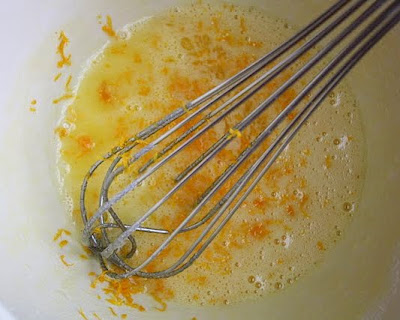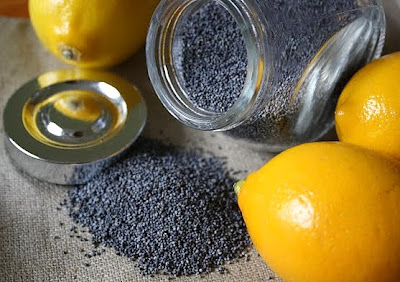Winter rages on and it's a frosty world out there. The sort of world that calls for big pots of chili, simmering endlessly on the stove, and shiny pans of homemade corn bread puffing up in the oven. Last weekend, that scenario described my kitchen to a T.
For a lunch meeting to be held at my church that Sunday, I cooked up just such a batch of steaming red chili, enough for about 40 people. Along with it went an equally hefty batch of fluffy, sunshine-yellow corn bread. What I didn't know, however, was that another couple also planned to provide a significant amount of food for the same event. I'd had a nagging suspicion that this might occur, but ignored it and didn't take the initiative to check it out first. No matter. It all worked out fine, of course, and the leftover chili -- about half of what I'd brought -- was poured into zip-loc bags and tucked into in the church's large freezer for future use.
The corn bread, though, didn't seem to me worth freezing. Not because it wasn't good. It was, in fact, a credit to its bready race--nicely moist, slightly sweet and, frankly, kind of hard for me to resist. But corn bread is one of those things, not unlike biscuits, that are only appealing eaten out of hand when incredibly fresh. Don't you think? After all, isn't it a widely accepted fact that corn bread's natural destiny is to dry out, crumble apart, and blow away like top soil in a dust storm?
In light of that harsh reality, I took two bags of the big, soft chunks home with me. This time, I pledged silently, I wasn't going to end up tossing it all in the garbage can. But other than using the stuff once or twice for poultry dressing in the past, I'd never explored surplus corn bread's potential. This time had to be different. There was far too much of it to toss into the trash guilt-free.
So I schemed. And that's how this warm, comforting, corn bread pudding recipe was born. Is it a dessert? Yes. Is it a fabulous brunch item, sort of breakfasty in its own way? Oh, yes to that, too. It's whatever you want it to be. Go ahead . . . explore the leftover corn bread possibilities. You won't be sorry. And your garbage can will thank you.
Sweet Corn Bread Pudding
with Raisins, Cinnamon, and Maple Syrup
(For a printable version of these recipes, click here!)
Make the corn bread first. (This is a very generic recipe that appears all over; I've seen it on grocery-store brand bags of corn meal, as well as on name-brand containers of corn meal. It's universal!)
Lightly grease an 8" x 8" or 9" x 9" baking pan.
Preheat oven to 400 degrees.
Ingredients for the corn bread:
3/4 cup corn meal (Not coarse grain; just the typical grocery store brand will do,)
1 and 1/4 cups All Purpose flour (I used unbleached.)
1/4 cup granulated sugar
1/2 tsp. salt (I used coarse kosher, and a pinch more than this, actually.)
2 tsp. baking powder
2 eggs, lightly beaten
1 cup milk (I used 2 percent)
1/4 cup vegetable oil or melted butter (I used canola oil.)
In a medium size bowl, whisk together the dry ingredients. In a smaller bowl, whisk together the liquids. Pour the liquids into the dry ingredients, and stir just to combine. Pour the batter into your prepared pan, and bake for about 20 minutes or so, until the top is lightly brown around the edges and a toothpick inserted in the center comes out clean. Cool on a rack, in the pan.
To make the bread pudding:
Lightly butter a deep casserole dish, approximately 9" x 9" or so. (A clear glass dish is your best bet for this.) Preheat oven to 325.
Ingredients for the bread pudding:
Approximately 6 cups of corn bread cubes (Cut generous bite-size cubes.)
2 cups milk (I used 2 percent)
1 cup heavy cream
4 large eggs, lightly beaten
1/2 cup pure maple syrup (I used Trader Joe's brand.)
1/2 cup sugar
1 tsp. ground cinnamon
1/4 tsp. salt (I used regular salt)
1/2 cup dark raisins (Or more if you're crazy about them.)
Spread the cubed corn bread out on a half-sheet pan (the kind with shallow sides), and put it in the 325 degree oven for about 15 minutes, until it feels dry but not until it looks toasted (it doesn't need to "color"). Remove it from the oven and set it aside to let it cool.
Turn the oven up to 350 degrees.
In a medium size mixing bowl, whisk together well the milk, cream, eggs, and maple syrup. In a small bowl, mix together the sugar, cinnamon, and salt. Add the sugar mixture to the liquids and whisk briskly.
Pile the cooled corn bread cubes into your prepared casserole dish. Sprinkle the raisins evenly over the cubes and tuck them in here and there so they're not just on the top of the pudding. Pour the liquid slowly over the cubes, taking care to make sure none are left completely dry. Lightly pat the top down a bit to help ensure every cube will absorb some of the liquid.
Let the pudding sit for 15 minutes or so before you put it in the oven, again to ensure that it has a chance to absorb the liquid.
Bake the pudding for approximately 60 minutes, until the top looks toasty and golden, and the bottom shows some golden color as well. The middle of the pudding should be wet but not jiggly. Check on the pudding about halfway through the baking time to be sure the top's not browning too quickly. Cover the top lightly with foil if that's starting to happen.
Cool the pudding on a rack, and serve it from the pan while still warm, each serving drizzled with a little maple syrup, if you like. Be sure to store any leftovers in the fridge.
(If you'd like to comment on this post, or to read any existing comments, please click on the purple COMMENTS below!)













































































